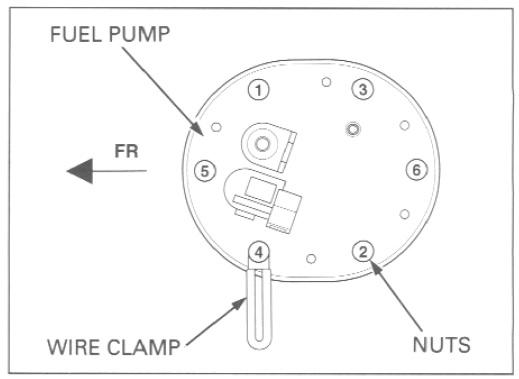Leaderboard
Popular Content
Showing content with the highest reputation on 03/16/2023 in all areas
-
The Problem: If your tank has rust or needs a clean out, this guide is for you. Although I used the POR15 kit in this guide, any similar products can be used (degreaser, metal etching acid or similar and a tank sealer paint), please follow the instructions for your products used. This guide was performed on a VFR800 Gen 5, but the steps apply to any tank, with just the disassembly / assembly steps and specific bike parts, will be a little different. Prep: Required: · 20 Litres White Vinegar (Optional) · POR15 Motorcycle Bike Fuel Tank Sealer Repair Kit (or similar treatment kit). · A bunch of old screws/length of chain. · A heat gun or hairdryer. When it says dry the tank, it is always force dry using either the heat gun or a hairdryer. · 10mm socket or spanner. · A long thin piece of metal like a brazing rod (if any of the ports are clogged) · Dish soap. · A syringe · 2 metal or strong plastic plates , sized and drilled to cover the 2 bottom ports ideally. Or anything that will seal the ports and not leak. (I personally used the bottom of a plastic paint bucket cut to size and sealed with silicone for the small port. I used the fuel pump assembly plate itself as I was replacing it, for the large port, it was not ideal, but it sealed well). · Duct Tape · Bicarbonate of Soda (1 cup will do) Parts List: · 91305-MC7-000 (for gen 5 VFR800, or equivalent fuel tank sealing o-ring). No. 43 in parts list. · 17574-MN5-000 (for gen 5 VFR800, or equivalent rubber base gasket). No. 23 in parts list. Safety: Wear eye protection when using any cleaning/prepping agents. Perform all steps in an adequately ventilated area, ideally outside. Wear correct gloves for metal prep and degreasing stages. Follow all labels on chemicals used. Steps: Remove the tank: 1. Run the bike until there is 1 or no bars on the fuel gauge. You want to have as little fuel in the tank as possible. 2. Siphon out any remaining fuel. 3. Remove the seat. 4. Remove the 2 front bolts holding down the front of the tank. (No. 50 in parts list) 5. Prop up the tank with something. I used an extendable window cleaning squidgy. 6. Disconnect the battery. 7. Put a cloth or similar under the tank area, to catch spills if any. 8. Put the tank on its side before removing the supply & return lines 9. Remove all tubing and electrical connectors from the bottom of the tank. Wrap in cloth to avoid spills. 10. Unscrew the 2 screws on the back of the tank. (No. 49 in parts list) 11. Remove the tank. 12. Remove the fuel pump assembly and fuel level sensor assembly using a 10mm spanner or socket. 13. Carefully remove the fuel pump assembly, it can be tricky to get out, so take it slowly. Rock the assembly gently back and forward to loosen it. You may need to compress the metal sponge slightly, that’s ok it is just like a sponge. Be careful not to damage the rubber surrounding the metal sponge. 13. Remove the fuel tank cap lock assembly. No.26 in parts list 14. Only 3 bolts need to be removed to get it out (see parts list) Clean out the tank: 1. Remove any fuel from tank using a siphon or syringe. Assuming the tank is rusty/dirty, dispose of this accordingly. 2. Rinse the tank very well with dish soap and water, then rinse out at least twice with clean water (warm is best). This is to remove any fuel remnants. 3. Dry straight after using the heat gun (on medium setting) or a hair dryer. I found using my heat gun on medium heat for ~2minutes blowing into each opening of the tank to be just hot enough, but not too hot, cycling between each side of the tank and letting cool between. Be careful not to get the tank too hot it will damage the paint. 4. Once the tank is bone dry (this can take an hour or more), dump some screws, a piece of chain, bolts etc. anything metal will work into the tank. This is to remove any surface rust. Make sure you know exactly what you put in as they can get stuck. 5. Shake the tank well with the metal pieces inside. Do it for as long as you can. I think I did it for around 1 hour. 6. Remove all the metal pieces you put in and all the rust. You can use a hoover to suck it up from the large port on the bottom of the tank. 7. Rinse the tank again with water to remove the last bits of surface rust. 8. Fully dry the tank again immediately with the heat gun/hairdryer. Soak tank in Vinegar (Optional): 1. Seal the bottom of the tank with whatever you have chosen. Tape up the 2 tubes on the bottom. 2. Pour the vinegar into the tank from the top. 3. Use duct tape to seal the top. 4. Leave to soak for a few days. Keep topped up. (I left it soak for 5 days). If your tank is really badly rusted you can leave for a lot longer and also replace with fresh vinegar after it becomes inactive. Once you keep the level full in the tank it will not rust any more with vinegar inside. After 5 days the level of vinegar in my tank had not dropped at all, indicating the tank was sealed well. 5. If the return port is clogged, now is a good time to use a long thing metal rod to unclog it. 6. Remove the vinegar and dispose. 7. Wash out the tank with some bicarbonate of soda and warm water. 8. Rinse out well with water. I personally removed the large cover to allow quick flow of water out of the tank and ran a hose at the top for about 5mins, moving the tank back and forward. 9. Dry immediately if not moving straight on to the next step. Degreaser: 1. Follow the POR15 degreaser instructions or degreaser of your choice. 2. I used the whole container of the POR15 degreaser with 1 equal container of hot water and sealed the tank. 3. Shake the liquid well, leaving to sit for 1-2 hours on each corner of the tank. I let it sit overnight on the bottom of the tank aswell as doing maybe 1 hour soaking on each end of the tank. 4. Rinse the tank out well again. 5. Dry immediately. Metal Prep: 1. Pour the metal prep into the tank and seal. 2. Shake around the whole tank for at least 20 minutes, making sure all surfaces are coated. 3. Pour the metal prep back into the bottle, it can be reused. 4. Rinse the tank out well with warm water. 5. Dry the tank immediately again. This time I actually left it beside a radiator after force drying, for a few days to make sure it was bone dry. Shake the tank around a bit while drying, as water can get trapped in crevices. Tank Sealer/Coating: 1. Take off the lid and stir the sealer very well until it is consistent. 2. Make sure the bottom of the tank and all bottom ports are sealed. 3. Pour the sealer into the tank, seal the top with duct tape. 4. Roll the sealer all around the tank. I did this for around 30mins, allowing it to sit in each corner for a few mins also. Make sure the tank is well coated. 5. Let the excess drain out of the tank if possible. For the VFR800 gen 5 tank, there is no way to do this due to the design of the tank. 6. I used the syringe to remove any excess sealer. You will need to do this a few times as the excess eventually flows towards the back of the tank. You basically want an even coat on the whole tank with no pooling. 7. Remove all port covers. 8. Allow to dry for at least 4 days, not force dried. I left mine for a week as you want this to be 100% dry before use. Reassembly: 1. Depending on how much corrosion/debris was in the tank and whether it got into the fuel system, you may need to clean your injectors/tubing etc. or replace the fuel filters. If this is the case you should do this before reassembling the tank. 2. If you need to install a new fuel cap, see here for removing the lock mechanism. 3. If you need to install a new fuel filter see here. 4. Assuming you are ready to reinstall the tank, using the new gasket and o-ring, reattach the fuel filter and fuel level sensor assemblies. They should be torqued to 14 N.m and apply a star pattern when torquing. 1. Screw back in the lock mechanism. 2. Follow tank removal steps in reverse. 3. Put a small bit of fuel in the tank maybe 1-2litres. Confirm the fuel level sensor registers the fuel. Start the engine. The process is now complete.1 point
-
Hi, they are like $5.00 US. I picked mine up at Home Depot, in the plumbing section, but Amazon has them too.1 point
















